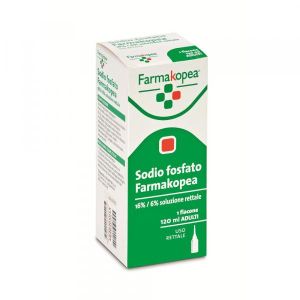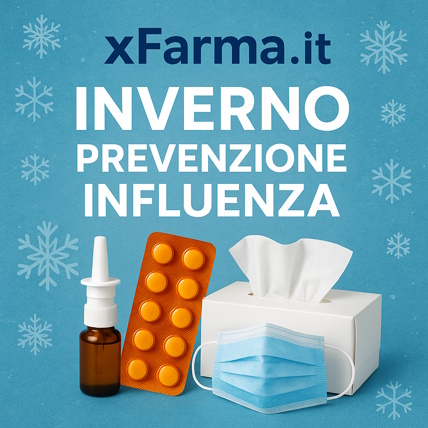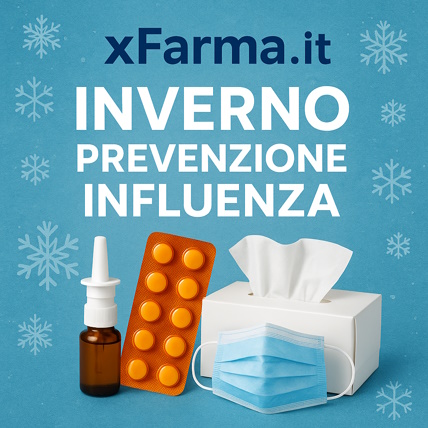Ship in Europe, Find out rates!
Language
Sodium Phosphate farmakopea 1 Bottle 120ml 16% + 6%

Regular Price
€3.70
Special Price
€2.19
-41%
Save: €1.51
Out of stock
- box Delivery in Italy in 24/48 and free returns
- star3.000+ positive reviews
- dropboxOver 60,000 products in the catalog
Sodio Fosfato Farmakopea 1 Flacone 120ml 16% + 6% Soluzione Rett
Manufacturer
FARMAKOPEA
SKU
030305015
Active principle
SODIO FOSFATO MONOBASICO MONOIDRATO/SODIO FOSFATO BIBASICO EPTAIDRATO
NAME
SODIUM PHOSPHATE FARMAKOPEA 16% / 6%
PHARMACOTHERAPEUTIC CATEGORY
Constipation medications.
ACTIVE PRINCIPLES
Monobasic sodium phosphate dihydrate 18.0 g (equal to monobasic sodium phosphate monohydrate 16.0g); dibasic sodium phosphate dodecahydrate 8.0 g (paria dibasic sodium phosphate heptahydrate 6.0 g).
EXCIPIENTS
100 ml of solution contain: methyl p-hydroxybenzoate, propyl p-hydroxybenzoate, purified water.
INDICATIONS
Treatment of constipation; clinical conditions that require pre and post-operative bowel emptying, in preparation for radiological examinations and endoscopic investigations of the last intestinal tract.
CONTRAINDICATIONS / SECONDARY EFFECT
Hypersensitivity to the active substance or to any of the excipients; acute abdominal pain or of unknown origin; nausea or vomiting; intestinal obstruction or stricture; intestinal subocclusion; mechanical ileus; paralytic ileus; inflammatory intestinal disorders and other conditions that may increase the absorption of the medicine; rectal bleeding of unknown origin; acute hemorrhoidal crisis with pain and bleeding; severe state of dehydration; children 'diet under twelve years old. Phosphates are contraindicated in patients with heart disease, severe renal insufficiency or in the presence of hyperphosphatemia.
DOSAGE
Adults and adolescents (12 - 18 years): 1 bottle of 120 ml. Do not use more than one bottle per day. Each bottle is to be used for one administration only; any residual medicine must be discarded. Administration can be practiced at room temperature. If you prefer lukewarm, just put the bottle in contact with hot water (by immersion or under the tap). For a better effect it is advisable to practice the administration in a lying position on the left side. For a greater cleaning action, assume the genupectoral position for a few minutes, immediately after administration. Instructions for use: screw the cannula onto the bottle; grasp the bottle and gently introduce the cannula into the rectum, then squeeze the bottle thoroughly. A residue of solution is expected to remain in the bottle. At the end of the administration, remove the cannula and discard the empty bottle in its own box according to the rules for disposing of medicines; lie down until urgent need to evacuate, which usually occurs within 5 minutes. In any case it is not necessary to hold the enema for more than 10-15 minutes.
STORAGE
It does not require any particular storage conditions. In tightly closed containers.
WARNINGS
The 120 ml bottle should not be used in children under the age of 12 years. The abuse of laxatives (frequent or prolonged use or with excessive doses) can cause persistent diarrhea with consequent loss of water, mineral salts (especially potassium) and other essential nutritional factors. In the most severe cases the onset of dehydration or hypokalemia is possible which can cause cardiac or neuromuscular dysfunctions, especially in the case of simultaneous treatment with cardiac glycosides, diuretics or corticosteroids. The abuse of laxatives can cause addiction (and, therefore, possible need to gradually increase the dosage), chronic constipation and loss of normal intestinal functions (intestinal atony). Repeated use of laxatives can give rise to addiction or damage of various kinds. Prolonged use of a laxative for the treatment of aspsis is not recommended. The pharmacological treatment of constipation must be considered an adjuvant to the hygienic-dietetic treatment (eg increase of vegetable fibers and fluids in the diet, physical activity and re-education of intestinal motility). The treatment of chronic or recurrent constipation always requires the intervention of the doctor for the diagnosis, the prescription of drugs and the surveillance during the course of therapy. Careful evaluation is essential when the need for the laxative derives from a sudden change in previous bowel habits (frequency and characteristics of bowel movements) that lasted for more than two weeks or when the use of thexative fails to produce effects. In episodes of constipation, it is advisable first of all to correct eating habits by integrating the daily diet with an adequate intake of fiber and water.When using laxatives it is advisable to drink at least 6-8 glasses of water or other liquids a day, in order to promote softening of stool. The product contains methyl p-hydroxybenzoate and propyl p-hydroxybenzoate: they can cause allergic reactions (even delayed).
INTERACTIONS
Systemic absorption of sodium phosphate rectal solution is limited; however in some conditions it may be increased and predispose to possible interactions with other drugs. The simultaneous intake of drugs that can have effects on the electrolyte balance (diuretics, steroids, etc.) can facilitate the onset of hyperphosphatemia, hypercalcemia and hypernatremia. Patients taking drugs capable of prolonging the QT interval may be at increased risk of developing this adverse reaction when treated concomitantly with sodium phosphate. Concomitant use of calcium supplements or calcium-containing antacids may increase the risk of ectopic calcification.
SIDE EFFECTS
The following are sodium phosphate side effects organized according to the MedDRA system organ class. Insufficient data are available to establish the frequency of the individual effects listed. Gastrointestinal disorders: isolated cramping pains or abdominal colic and diarrhea, with loss of fluids and electrolytes, more frequent in cases of severe constipation, as well as rectal irritation. Metabolism and Nutrition Disorders: Hyperphosphatemia, hypocalcemia and tissue calcification may rarely occur.
PREGNANCY AND BREASTFEEDING
There have been no adequate and well-controlled studies on the use of the medicine during pregnancy or breastfeeding. Although there are no obvious contraindications to the use of the medicine during pregnancy and breastfeeding, it is recommended to take the medicine only in case of need.
SODIUM PHOSPHATE FARMAKOPEA 16% / 6%
PHARMACOTHERAPEUTIC CATEGORY
Constipation medications.
ACTIVE PRINCIPLES
Monobasic sodium phosphate dihydrate 18.0 g (equal to monobasic sodium phosphate monohydrate 16.0g); dibasic sodium phosphate dodecahydrate 8.0 g (paria dibasic sodium phosphate heptahydrate 6.0 g).
EXCIPIENTS
100 ml of solution contain: methyl p-hydroxybenzoate, propyl p-hydroxybenzoate, purified water.
INDICATIONS
Treatment of constipation; clinical conditions that require pre and post-operative bowel emptying, in preparation for radiological examinations and endoscopic investigations of the last intestinal tract.
CONTRAINDICATIONS / SECONDARY EFFECT
Hypersensitivity to the active substance or to any of the excipients; acute abdominal pain or of unknown origin; nausea or vomiting; intestinal obstruction or stricture; intestinal subocclusion; mechanical ileus; paralytic ileus; inflammatory intestinal disorders and other conditions that may increase the absorption of the medicine; rectal bleeding of unknown origin; acute hemorrhoidal crisis with pain and bleeding; severe state of dehydration; children 'diet under twelve years old. Phosphates are contraindicated in patients with heart disease, severe renal insufficiency or in the presence of hyperphosphatemia.
DOSAGE
Adults and adolescents (12 - 18 years): 1 bottle of 120 ml. Do not use more than one bottle per day. Each bottle is to be used for one administration only; any residual medicine must be discarded. Administration can be practiced at room temperature. If you prefer lukewarm, just put the bottle in contact with hot water (by immersion or under the tap). For a better effect it is advisable to practice the administration in a lying position on the left side. For a greater cleaning action, assume the genupectoral position for a few minutes, immediately after administration. Instructions for use: screw the cannula onto the bottle; grasp the bottle and gently introduce the cannula into the rectum, then squeeze the bottle thoroughly. A residue of solution is expected to remain in the bottle. At the end of the administration, remove the cannula and discard the empty bottle in its own box according to the rules for disposing of medicines; lie down until urgent need to evacuate, which usually occurs within 5 minutes. In any case it is not necessary to hold the enema for more than 10-15 minutes.
STORAGE
It does not require any particular storage conditions. In tightly closed containers.
WARNINGS
The 120 ml bottle should not be used in children under the age of 12 years. The abuse of laxatives (frequent or prolonged use or with excessive doses) can cause persistent diarrhea with consequent loss of water, mineral salts (especially potassium) and other essential nutritional factors. In the most severe cases the onset of dehydration or hypokalemia is possible which can cause cardiac or neuromuscular dysfunctions, especially in the case of simultaneous treatment with cardiac glycosides, diuretics or corticosteroids. The abuse of laxatives can cause addiction (and, therefore, possible need to gradually increase the dosage), chronic constipation and loss of normal intestinal functions (intestinal atony). Repeated use of laxatives can give rise to addiction or damage of various kinds. Prolonged use of a laxative for the treatment of aspsis is not recommended. The pharmacological treatment of constipation must be considered an adjuvant to the hygienic-dietetic treatment (eg increase of vegetable fibers and fluids in the diet, physical activity and re-education of intestinal motility). The treatment of chronic or recurrent constipation always requires the intervention of the doctor for the diagnosis, the prescription of drugs and the surveillance during the course of therapy. Careful evaluation is essential when the need for the laxative derives from a sudden change in previous bowel habits (frequency and characteristics of bowel movements) that lasted for more than two weeks or when the use of thexative fails to produce effects. In episodes of constipation, it is advisable first of all to correct eating habits by integrating the daily diet with an adequate intake of fiber and water.When using laxatives it is advisable to drink at least 6-8 glasses of water or other liquids a day, in order to promote softening of stool. The product contains methyl p-hydroxybenzoate and propyl p-hydroxybenzoate: they can cause allergic reactions (even delayed).
INTERACTIONS
Systemic absorption of sodium phosphate rectal solution is limited; however in some conditions it may be increased and predispose to possible interactions with other drugs. The simultaneous intake of drugs that can have effects on the electrolyte balance (diuretics, steroids, etc.) can facilitate the onset of hyperphosphatemia, hypercalcemia and hypernatremia. Patients taking drugs capable of prolonging the QT interval may be at increased risk of developing this adverse reaction when treated concomitantly with sodium phosphate. Concomitant use of calcium supplements or calcium-containing antacids may increase the risk of ectopic calcification.
SIDE EFFECTS
The following are sodium phosphate side effects organized according to the MedDRA system organ class. Insufficient data are available to establish the frequency of the individual effects listed. Gastrointestinal disorders: isolated cramping pains or abdominal colic and diarrhea, with loss of fluids and electrolytes, more frequent in cases of severe constipation, as well as rectal irritation. Metabolism and Nutrition Disorders: Hyperphosphatemia, hypocalcemia and tissue calcification may rarely occur.
PREGNANCY AND BREASTFEEDING
There have been no adequate and well-controlled studies on the use of the medicine during pregnancy or breastfeeding. Although there are no obvious contraindications to the use of the medicine during pregnancy and breastfeeding, it is recommended to take the medicine only in case of need.
| Destination | Cost | Detail |
|---|---|---|
| Italy | €5,90* | 24/72H |
| Austria, France, Germany, Slovenia | € 13* | 3 days |
| Belgium, Luxembourg, Portugal, Netherlands, Spain | € 14* | 4 days |
| Bulgary, Cechia, Hungary, Poland, Romania, Slovakia | € 19* | 5 days |
| Denmark, Estonia, Finland, Ireland, Lithuania, Latvia ,Sweden | € 22* | 5 days |
| United Kingdom, Switzerland, Greece, Malta/td> | € 30* | 7 days |
| Canada | € 40 | 7 Days |
European shipments with express courier: FedEx, MBE, DHL
*For the shipment outside band B ther's an extra cost of 22€ *For the shipment outside band C ther's an extra cost of 30€ Delivery Times exclude Saturday and Holidays
For Islands and Areas of difficult Accessibility the shipments are made in 72 hours and the cost will be increased by 15€
The images of the products shown on our site are purely indicative and may differ in shape, color, text and packaging shown on them. Given the difficulty of updating all the products on our site in real time or any errors, XFarma.it, all products will be identified through SKU MINSAN (code of the Ministry of Health).

